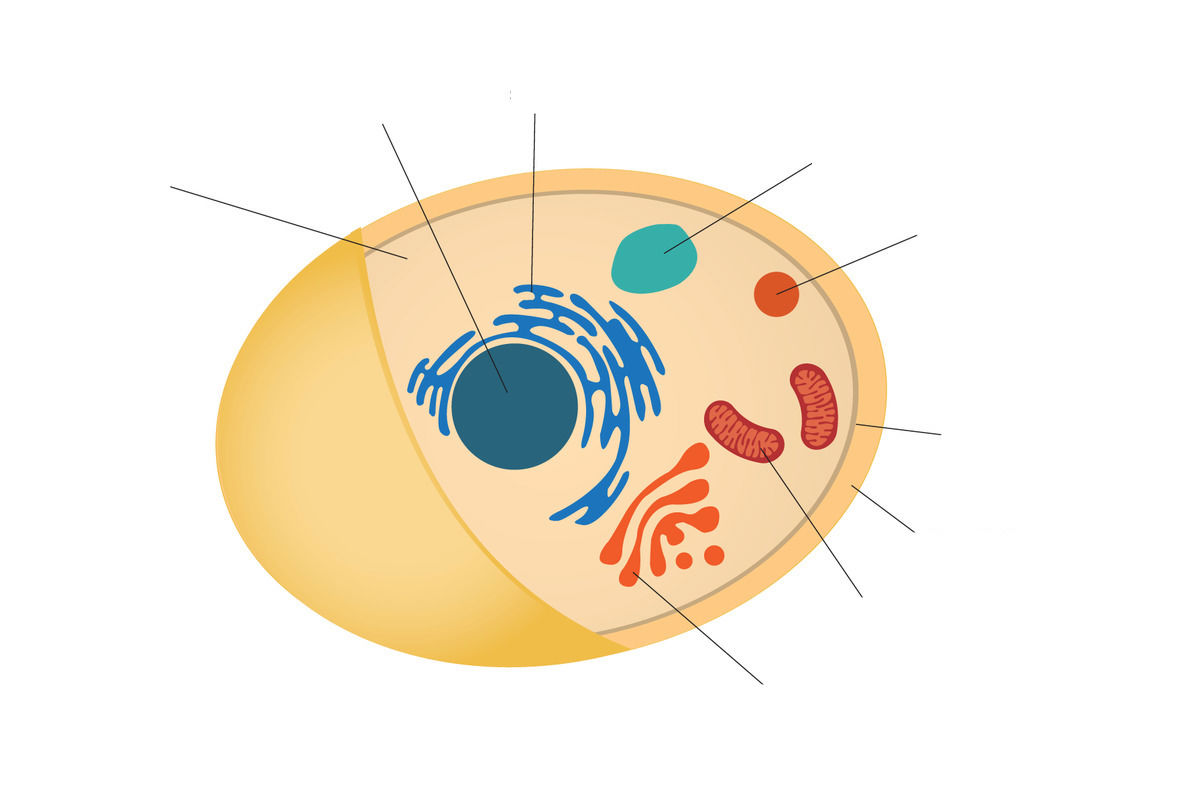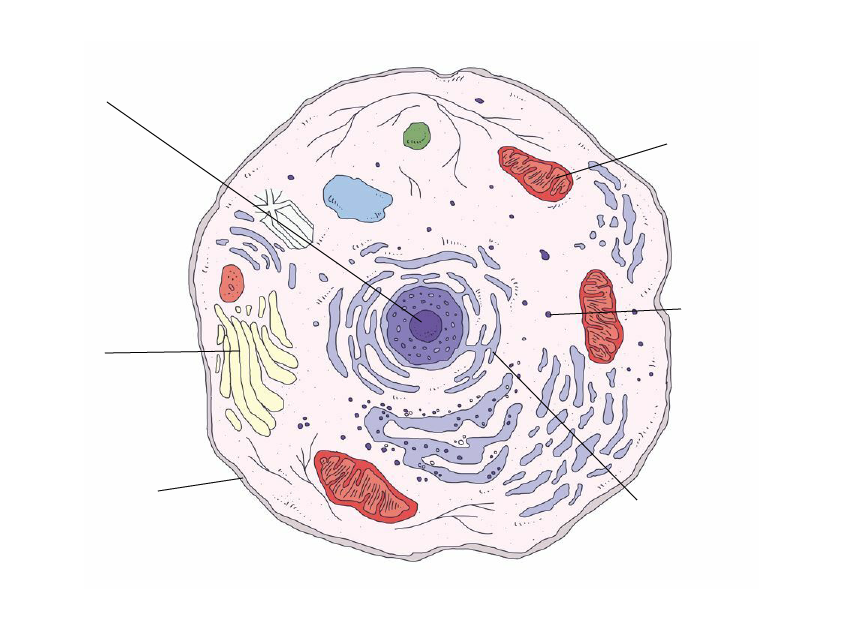Introduction
All organisms are made up of cells. Most cells are small and cannot be seen with the naked eye. There are many reasons for the small size of cells. A small cell can exchange matter with its environment more quickly than a large cell. Because cells are small, the transport of substances to different parts of the cell is faster, which means that cellular metabolism is also more efficient. Small cells can also divide more quickly. They can form complex entities such as tissues and organs.
A large number of organelles are located inside the cell. In these organelles, a huge number of complex functions take place. Even the simplest of organisms produce hundreds of different proteins that are involved in metabolism and reproduction.
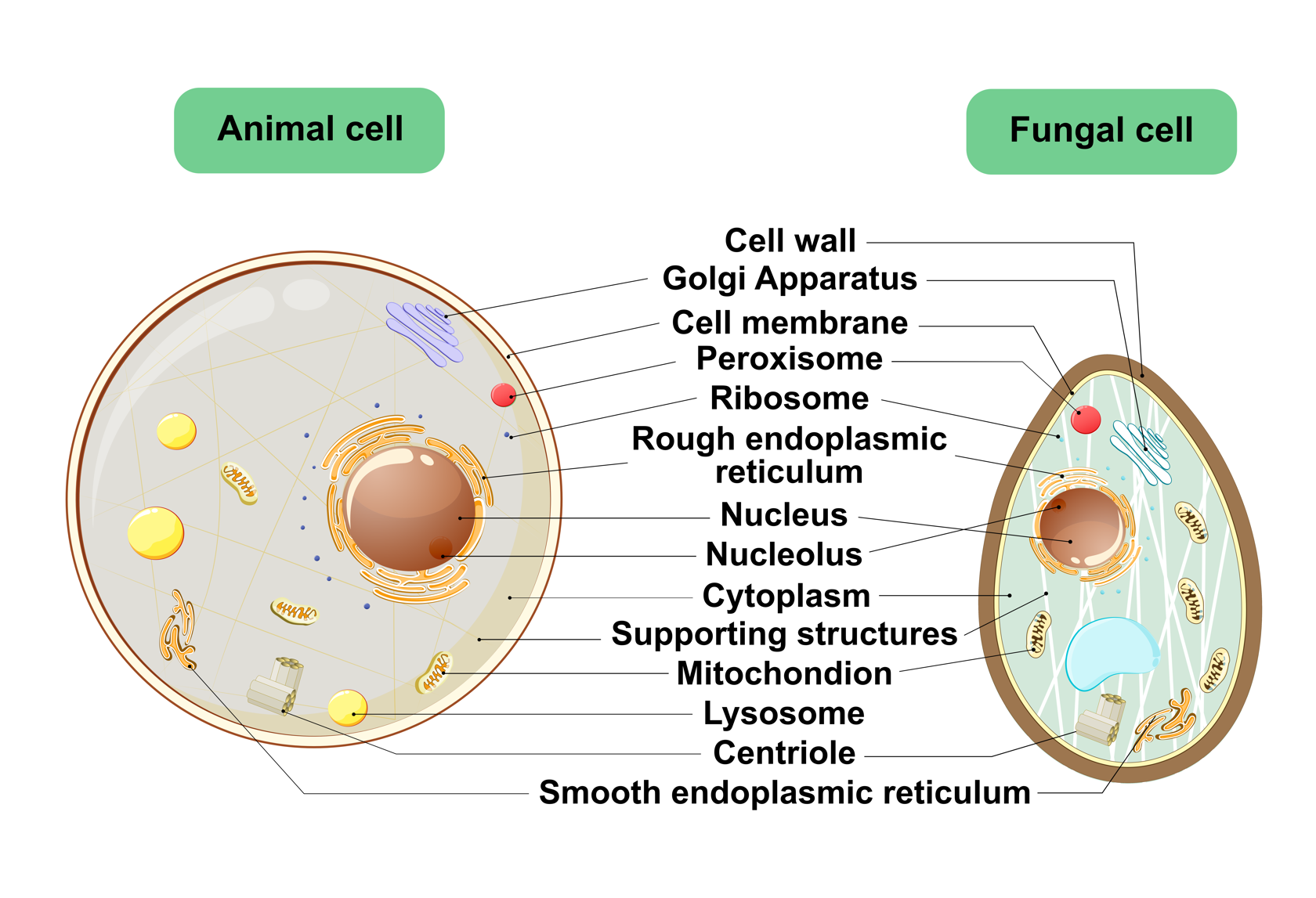
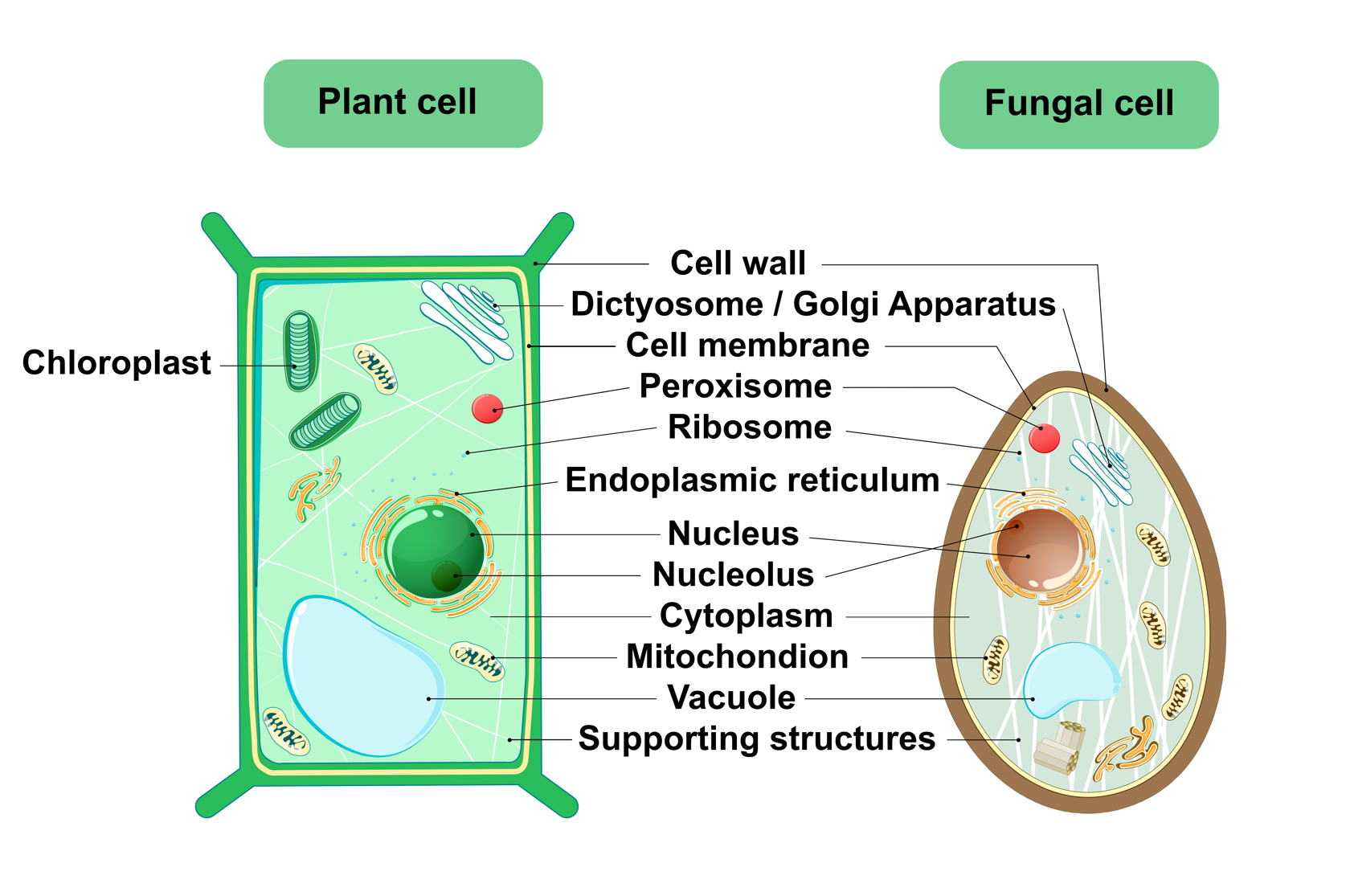
Common characteristics of cells
Plant, fungal and animal cells can look very different when viewed under a microscope. The shape, size and function of cells can vary greatly. However, all cells have a similar basic structure.
DNA controls the function of all living cells. DNA is divided into chromosomes, which contain genes that determine the structure of the products that control cell function. In protein synthesis, the information contained in the DNA is transferred to a messenger RNA molecule (transcription) and the information in the messenger RNA is used to make proteins at the ribosomes (translation). All cells produce RNA and proteins in the same way.
Cells can also reproduce and divide. A cell can produce copies of itself by mitosis. Cells in sexually reproducing organisms can also divide by meiosis, in which the number of chromosomes in a cell is halved.
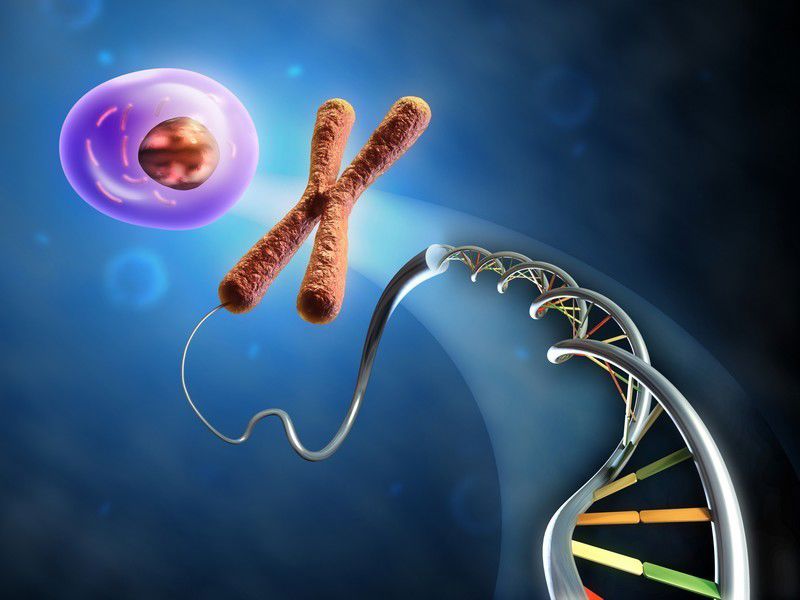
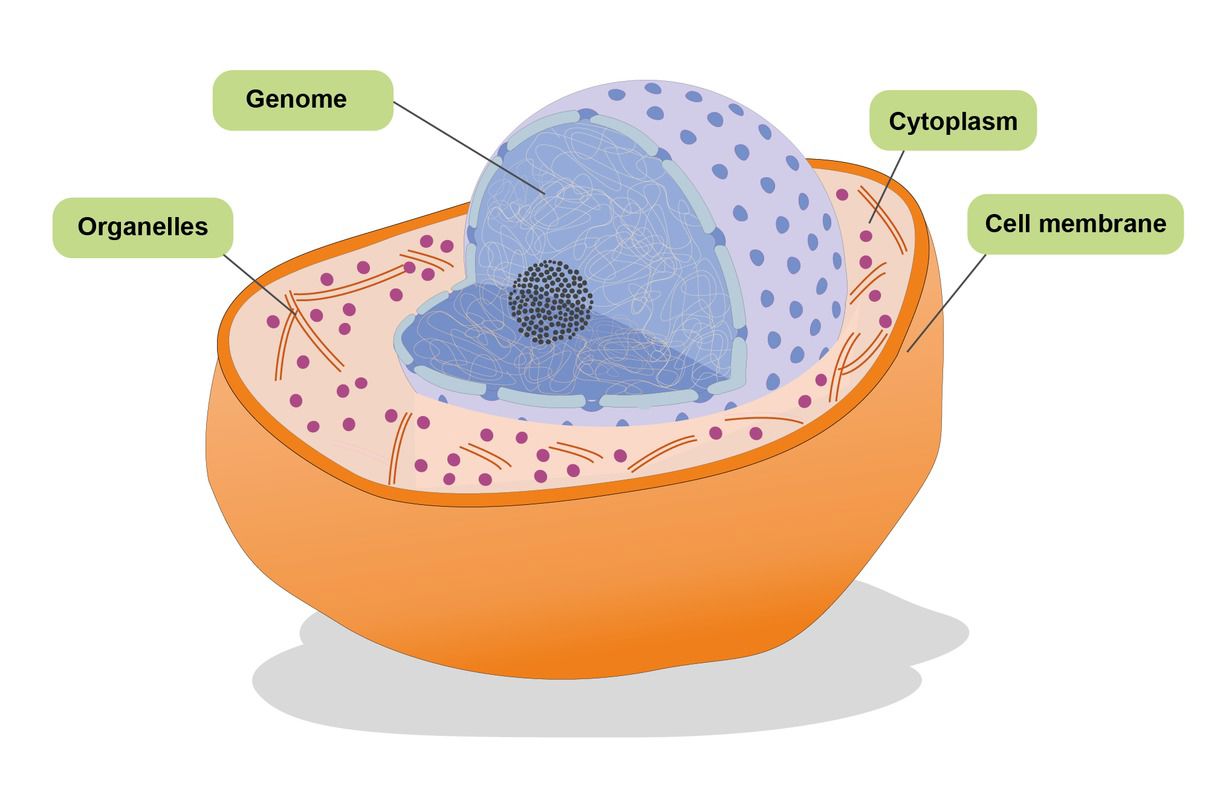
All cells have a similar chemical structure and undergo similar chemical reactions. Cells are rich in different macromolecules, such as proteins, carbohydrates and nucleic acids. There are also similarities in the structures of macromolecules. Many cellular proteins act as enzymes that speed up chemical reactions.
The cell is surrounded by a cell membrane that separates it from its environment. In addition, many cells are also protected by a cell wall. The space inside the cell membrane is called the cytoplasm. The cytoplasm is made up of cell organelles and liquid cytosol. In addition to water, the cytosol is rich in salts, proteins and amino acids.
The energy metabolism of cells is also similar in all organisms. In cells, ATP acts as a temporary energy reserve. For example, in photosynthesis and cellular respiration, energy is temporarily stored in ATP. A cell can use the chemical energy in ATP for tasks such as metabolism, reproduction or locomotion.
- cell
- protein molecule
- carbon atom
- mitochondrion
- virus
- enzyme
- mitochondrion
- sugar
- cell membrane
- Golgi apparatus
- ribosome
- cytoplasm
- cytoskeleton
Prokaryotic and eukaryotic cells
Prokaryotic cells are simple compared to eukaryotic cells. Prokaryotes are single-celled organisms that do not have a nucleus. Bacteria and archaea are considered to be prokaryotes. Archaea differ from bacteria in many ways, for example in terms of the structure of their cell membrane and cell wall. Archaea and baceteria also have many differences in terms of protein synthesis. Archaea are more closely related to eukaryotes than bacteria.
The function of a prokaryotic cell is controlled by DNA, which is usually located in ring-shaped chromosomes. Some prokaryotes have smaller ring-shaped DNA molecules called plasmids in addition to chromosomes. The function of prokaryotes is discussed in more detail in the sixth module of high school biology.

Eukaryotic cells have similar features to prokaryotic cells. However, they have structures and properties that the more primitive prokaryotes lack. In eukaryotic cells, DNA is stored in chromosomes inside a nucleus enclosed by a double membrane.
Additionally, eukaryotic cells contain membranous cell organelles, which are not found in prokaryotic cells. Such organelles include energy-producing mitochondria and chloroplasts. Plant and fungal cells, as well as those of many protists, are surrounded by a cell wall, whereas animal cells lack this structure.
Prokaryotes and eukaryotes
Feature | Prokaryotes | Eukaryotes |
Cell surrounded by | Cell membrane and often also cell wall | Cell membrane and often also cell wall (in plants, fungi and many protists) |
Location of genome | Cytoplasm | Nucleus |
Organelles | Only small organelles, such as ribosomes | Also membranous organelles (e.g. mitochondria, chloroplasts) |
Number of cells | Only unicellular organisms | Both unicellular and multicellular organisms |
Groups of organisms | Bacteria and archaea | Protists, plants, animals and fungi |
Parts of the cell
Animal, fungal and plant cells share many of the same structures and organelles. On the other hand, all cells of an individual do not contain the same organelles and structures. For example, a red blood cell has no mitochondria at all, but a liver cell may have thousands of them.

Parts of the cell
Structure or organelle | Animal cell | Plant cell | Fungal cell | Which eukaryotes? | Structural description | Function |
Cell membrane | X | X | X | All eukaryotes | Double lipid membrane | Protects and insulates the cell from its environment. Through the cell membrane, the organism takes in and removes substances according to its needs. |
Cytoplasm | X | X | X | All eukaryotes | The material inside the cell membrane and outside the nucleus, the liquid part of which (water and substances dissolved in it) is called the cytosol | Many reactions take place in the cytoplasm |
Ribosome | X | X | X | Found in the cytoplasm of all organisms, also in mitochondria and chloroplasts | Proteins and RNA | Produces proteins |
Nucleus | X | X | X | All eukaryotes | Surrounded by a nuclear envelope, contains chromosomes | Stores the genome and reads DNA |
Cell wall | X | X | Plant and fungal cells | Cellulose in plants, chitin in fungi | Supports and insulates the cell | |
Mitochondrion | X | X | X | All eukaryotes | Double membrane, inner membrane folded, has its own DNA | Releases energy in cellular respiration |
Chloroplast | X | Plants, some protists | Double membrane, contains membranous compartments, has its own DNA | Photosynthesis | ||
Endoplasmic reticulum | X | X | X | All eukaryotes | Membranous compartments. Divided into rough and smooth endoplasmic reticulum. The rough endoplasmic reticulum contains ribosomes that produce proteins inside the membrane. | Transports, stores and produces proteins |
Golgi apparatus (dictyosome in plants) | X | X | X | Many eukaryotes | Membranous compartments | Transports proteins |
Vesicle | X | X | X | All eukaryotes | Membrane vesicle | Transports, stores and breaks down products or waste products of cellular functions. |
Vacuole | X | X | Plant and fungal cells | Membrane vesicle | Stores liquids, breaks down substances | |
Lysosome | X | (X)[annotation: Sometimes, certain vacuoles of fungal cells are called lysosomes.] | Many animal cells | Membrane vesicle, many enzymes, low pH | Breaks down many biomolecules and e.g. bacteria (which have entered the cell through the cell membrane) | |
Proteasome | X | X | X | All eukaryotes | Protein complex | Breaks down proteins (breaks peptide bonds) |
Peroxisome | X | X | X | All eukaryotes | Membrane vesicle | Breaks down e.g. fatty acids |
Centriole | X | X | X | Animal and fungal cells, some plant cells | Consists of microtubules | Participate in cell division by pulling doubled organelles and chromosomes into each of the two nascent cells by microtubules |
Microfilaments and intermediate filaments | X | X | X | All eukaryotes | Consist of proteins | Transport parts of the cell during mitosis, meiosis and cell division |
Cilium and flagellum | X | X | X | On the outer surface of some cells | The structure (e.g. length) and function vary | Used for movement |
Plasmid (DNA ring) | (X) | Some yeast cells | Ring-shaped DNA molecule | Part of the genome |
The structure and function of organelles
The nucleus controls the function of the eukaryotic cell
In eukaryotes, the nucleus acts as a repository for the cell's genetic material. In the nucleus, this genetic material is stored in the form of DNA in chromosomes.
Eukaryotes usually have several chromosomes with straight, chain-like structures. In these chromosomes, DNA is combined with proteins to form tightly packed chromatin.
The DNA contains genes that control the function of the cell. A gene is a specific sequence of DNA that causes a cell to produce a specific compound, either protein or RNA, that affects its function.
The nucleus is surrounded by a nuclear envelope that consists of two double membranes. The envelope contains small holes, called nuclear pores, which allow substances to pass in and out of the nucleus.
The nucleus contains nucleoplasm and a nucleolus. The nucleolus can be distinguished as the darker area inside the nucleus. It is where parts of ribosomes (ribosomal RNA), which are needed to build proteins, are produced.
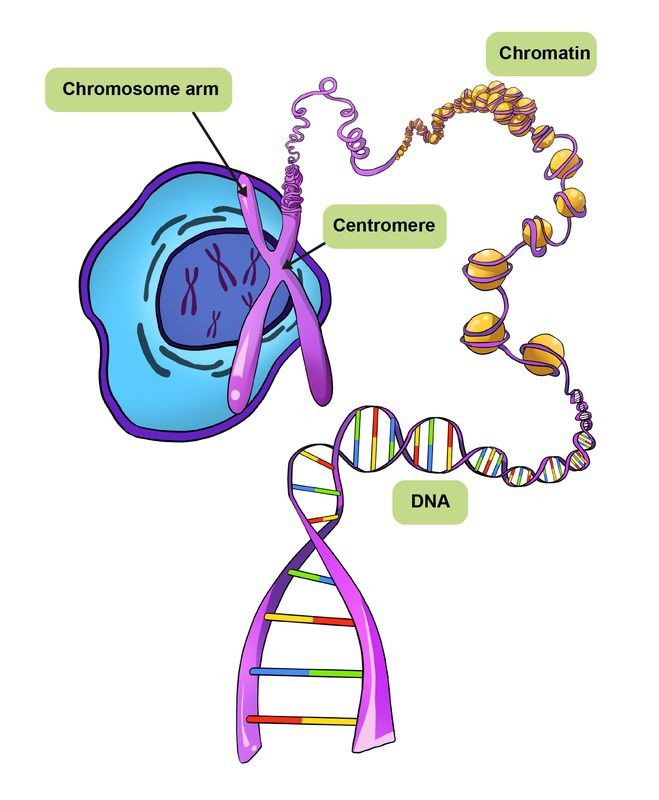
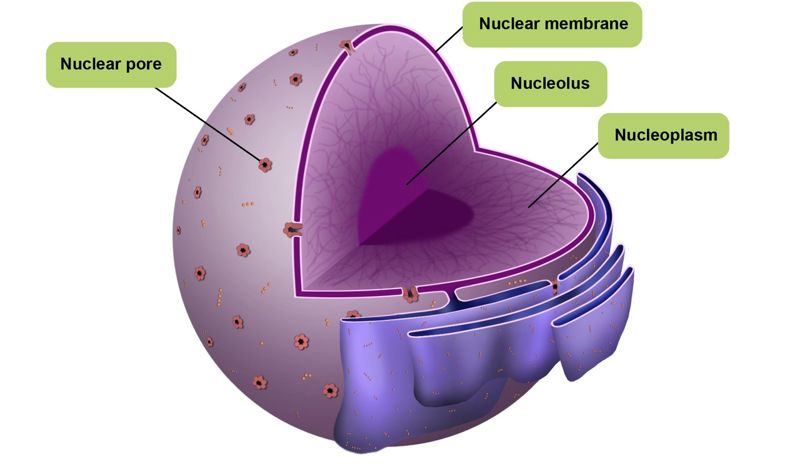
Mitochondria and chloroplasts are involved in energy metabolism
Mitochondrion
The mitochondrion can be described as the powerhouse of the cell, as it is where many of the cell's energy metabolism reactions take place. These reactions include cellular respiration and the oxidation of fatty acids. The mitochondrion converts the chemical energy contained in organic molecules into a form that the cell can use.
The mitochondrion is a tiny organelle, about one micrometre long. It is surrounded by two membranes, and the space around the inner membrane is called the mitochondrial matrix. The inner membrane of the mitochondrion is where the citric acid cycle and electron transfer chain reactions of cellular respiration take place. These reactions are described in more detail later in book. The inner membrane of the mitochondrion has a folded structure.
The mitochondrion is thought to have originated from a bacterium that lived in symbiosis with the cell. This endosymbiosis theory is supported by the fact that mitochondria have their own DNA and ribosomes.
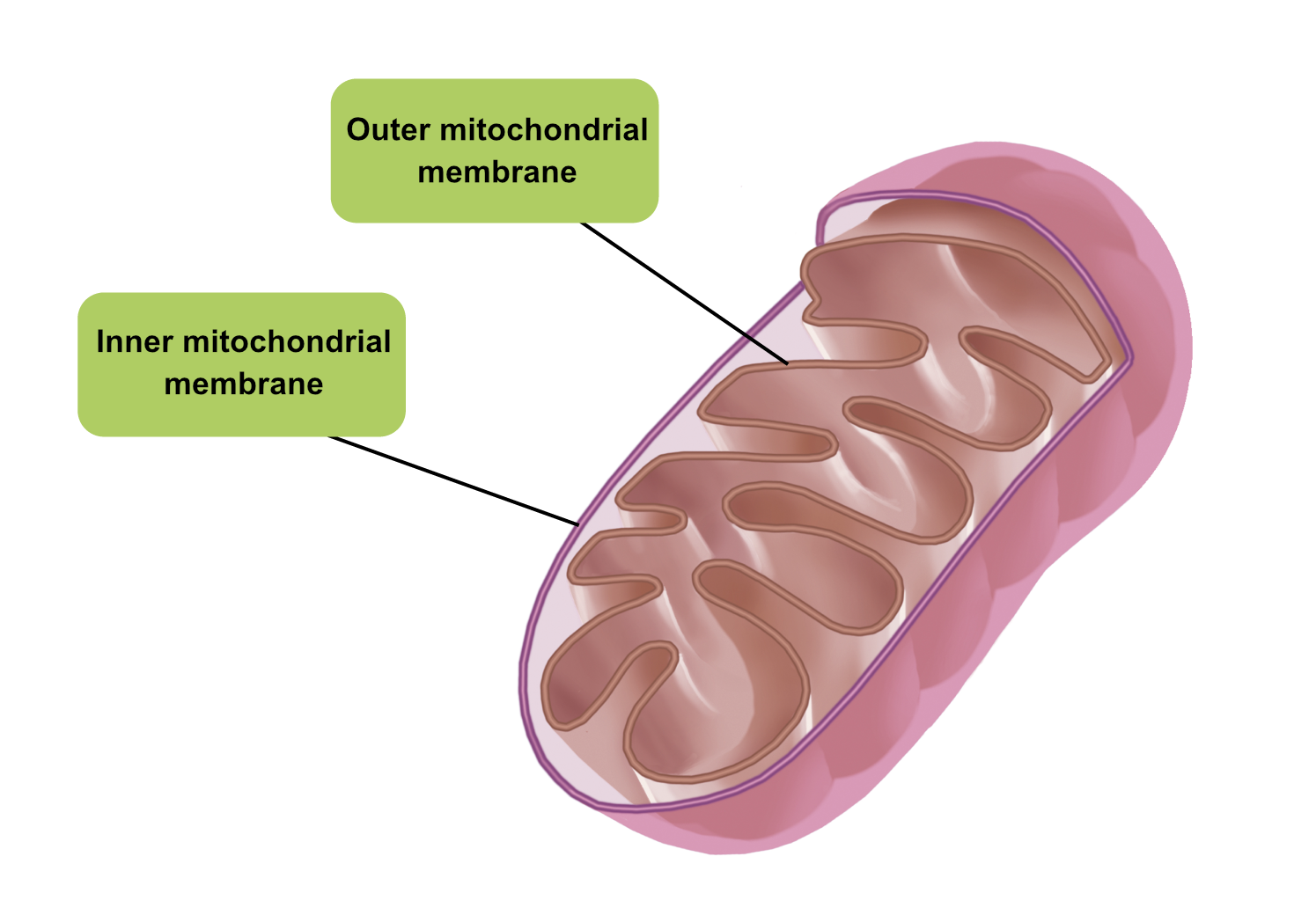
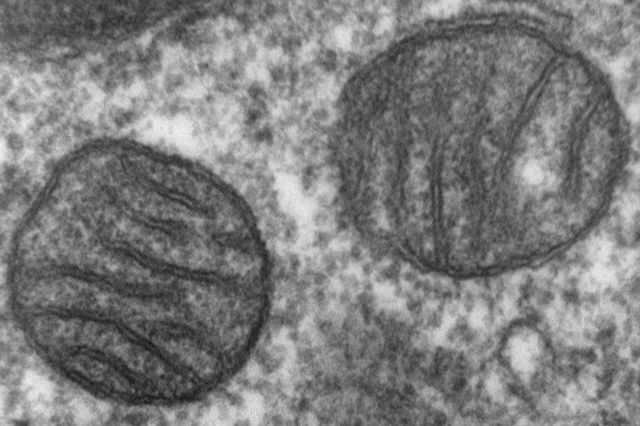
Chloroplast
The chloroplast is an organelle that is found only in photosynthetic eukaryotes (i.e. plants and algae). Chloroplasts use photosynthesis to convert solar radiation energy into chemical energy. In photosynthesis, the energy from sunlight is used to produce organic compounds, such as sugar, from carbon dioxide and water. At the same time, oxygen is released into the environment.
Like the mitochondrion, the chloroplast is surrounded by two membranes (A and B in the image below), but the chloroplast also contains membrane vesicles (thylakoids, C in the image below), which form the photosynthetic membranes. Photosynthetic reactions take place on the surface of these membranes.
Like mitochondria, chloroplasts also have their own DNA and ribosomes. This is why they are thought to have evolved from cyanobacteria that lived in close association with nucleated cells (endosymbiosis).

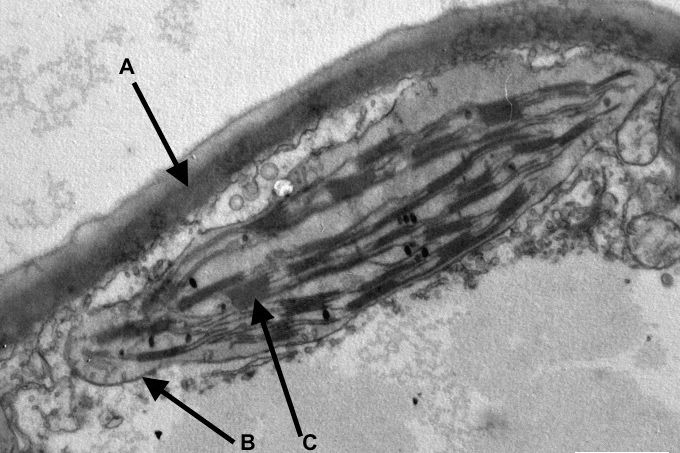
Many organelles have membranous structures
In addition to the nuclei, mitochondria and chloroplasts, cells contain many other membranous structures that are necessary for the transport and secretion of substances. Membranous organelles are typical for eukaryotes. Bacteria and archaea may instead have membranous structures formed from the cell membrane which are used for energy production.
Endoplasmic reticulum
The endoplasmic reticulum consists of many interconnected membrane compartments and vesicles. The endoplasmic reticulum can be divided into two parts: rough and smooth endoplasmic reticulum.
The rough endoplasmic reticulum carries ribosomes, which produce proteins inside the membrane compartments of the endoplasmic reticulum. Proteins transported to other membranous organelles inside the cell or out of the cell are produced inside the membrane compartments. When viewed through a microscope, the ribosomes attached to the rough endoplasmic reticulum are visible, which is why the structure of the reticulum appears “rough”.
The smooth endoplasmic reticulum is structurally similar to the rough endoplasmic reticulum, but it does carry ribosomes. Smooth endoplasmic reticulum is used, for example, to build new cell membranes and to break down contaminants such as pharmaceuticals and toxic compounds.
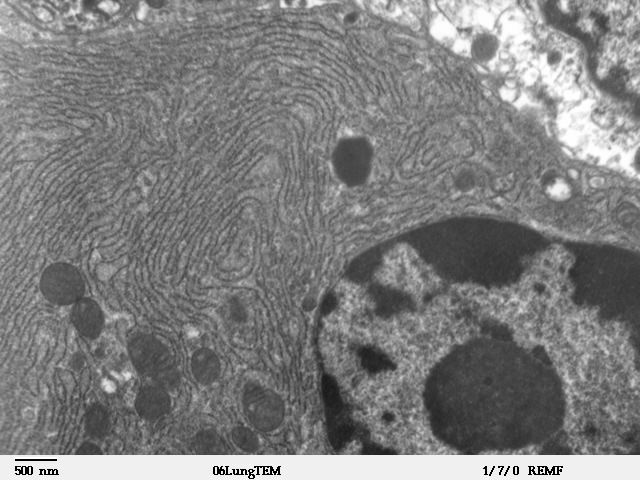
Golgi apparatus
The Golgi apparatus can be described as the freight hub of the cell. It is where proteins are sorted for transport and secretion. In the Golgi apparatus, proteins can also be modified, for example by attaching sugar components to them. The Golgi apparatus is closely associated with the endoplasmic reticulum, and small membrane vesicles are constantly moving between them.
In plant cells, the Golgi apparatus is sometimes called the dictyosome. However, its function in both plant and animal cells is broadly similar.
Lysosome
The lysosome can be called the cell's recycling centre, as it is where unnecessary proteins and contaminants are broken down. The pH inside the lysosome is clearly acidic. This, together with various enzymes, promotes the breaking down of substances.
The phagocytes of the immune defence system destroy harmful bacteria in the acidic lysosome. Lysosomes are only found in animal cells. In plant cells, the role of lysosomes is played by vacuoles.
Peroxisome
The peroxisome is a membranous structure that is responsible for breaking down fatty acids, among other things. As a by-product, they produce reactive hydrogen peroxide, from which the peroxisomes get their name. Peroxisomes are found in plants, animals and almost all other eukaryotes.
Vacuole
The vacuole is an organelle found in both plant and fungal cells. It is a membranous, fluid-filled vesicle that can fill almost the entire cell, especially in old cells. Plant cell growth is therefore largely based on an increase in the volume of the vacuole. The vacuole stores nutrients, salts and waste products and breaks down some macromolecules. In a plant cell, the vacuole performs similar functions to the lysosome of an animal cell.
Many cellular structures are made of proteins
Supporting structures of cells
The internal structure of the cell is held together by three types of structures: microfilaments made of actin, intermediate filaments made of keratin and microtubules.
Actin filaments are associated with movement. In muscle cells, they trigger muscle movements together with myosin filaments. The centrosome, which consists of microtubules, is a central structure in cell division. The supporting structures of the cell can also form cilia or flagella, which help the cell to move and adhere to different surfaces.
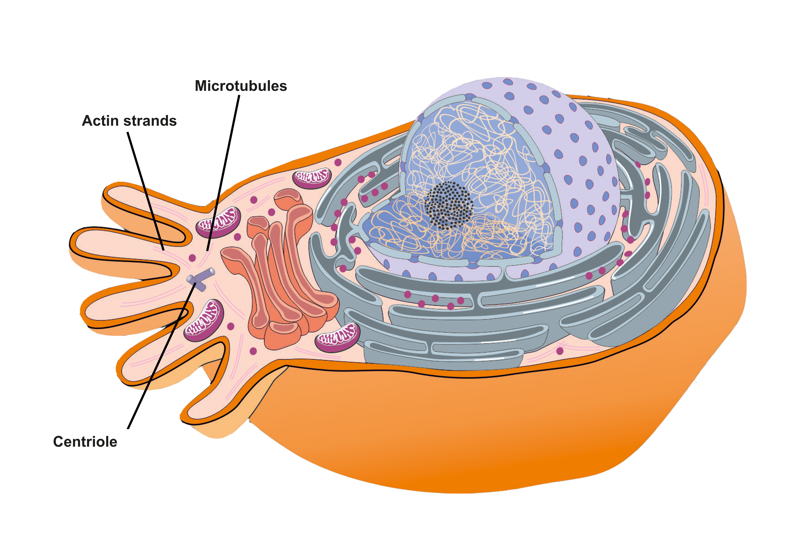
Ribosome
The ribosome is a large molecule made up of proteins and RNA that produces proteins following the template encoded by DNA. Ribosomes can either float freely in the cytoplasm or be attached to the cell membrane. The ribosome consists of two subcomponents: a large and a small one. The ribosomes of eukaryotes are slightly larger than those of prokaryotes.
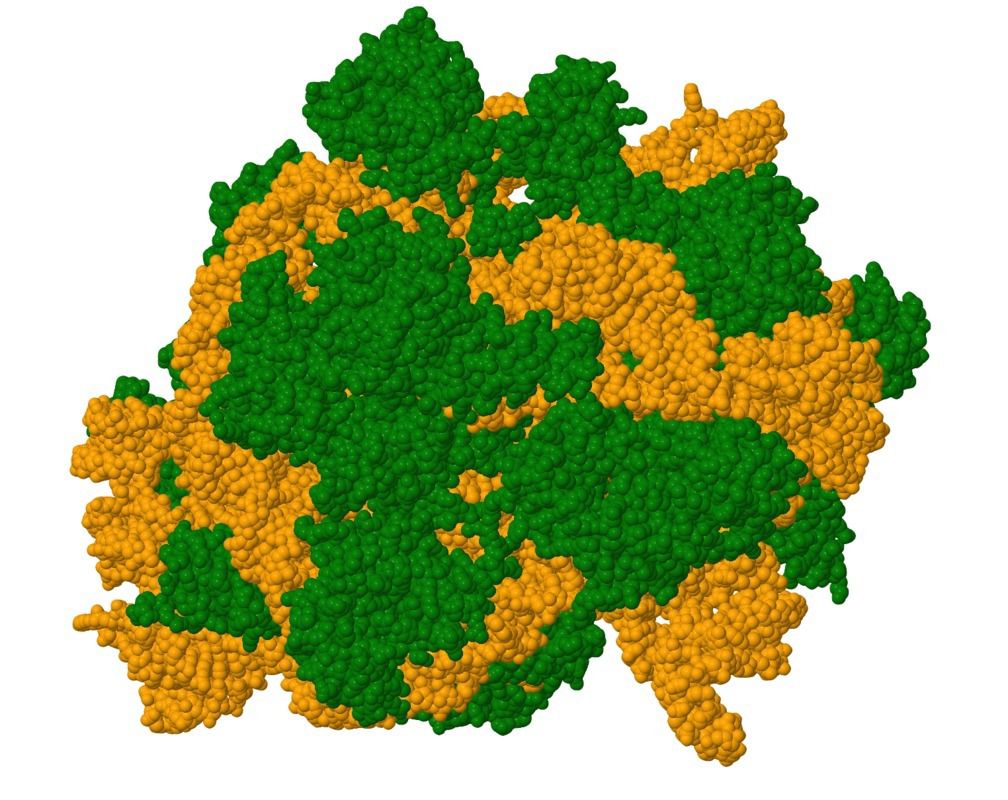
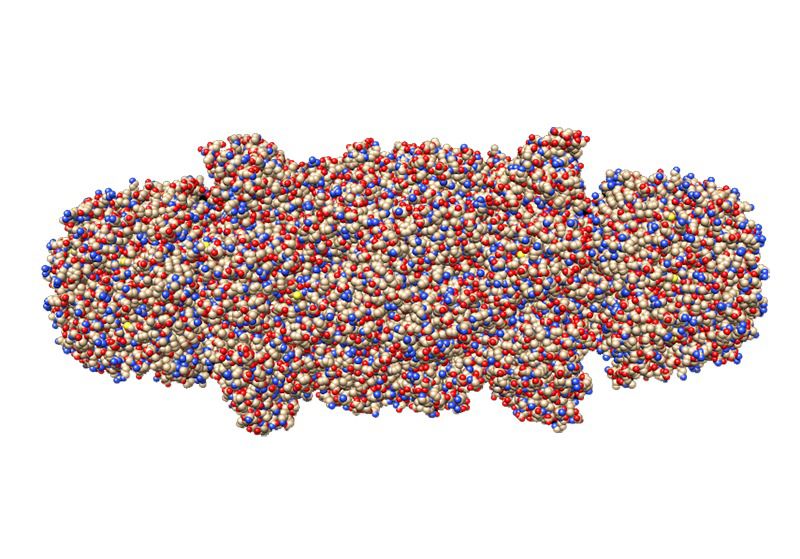
Proteasome
The proteasome is a structure made up of several proteins. Its function is to break down unnecessary proteins. The proteasome recognises proteins that are marked for breakdown and cuts them into smaller parts.
The cell membrane and the cell wall separate the cell from its environment
Cells need different structures to retain their shape and prevent them from breaking down. All cells are surrounded by a cell membrane, which separates the cell from its environment. The cell membrane also regulates the flow of substances in and out of the cell.
In plant and fungal cells, and in many bacteria, the cell is surrounded by a cell wall. The cell wall consists mainly of cellulose in plants, of chitin in fungi and of peptidoglycan or murein in bacteria. Animal cells do not have a cell wall.
- Fungal cells have chloroplasts.
- Fungal cells have a cell wall.
- Animal cells have a cell wall.
- The cell membrane has a flexible structure.
- The vacuole is a typical organelle in old plant cells.
- The ribosome plays a part in protein synthesis.
- The lysosome plays a part in protein synthesis.
- The Golgi apparatus sorts proteins for transport.
- The endoplasmic reticulum produces proteins that are secreted out of the cell.
- The proteasome is an organelle where new proteins are produced.
- The lysosome breaks down proteins, among other things.
Extracellular matrix
In animal tissues, cells are bound together by an extracellular matrix (ECM). It contains substances such as collagen (a filamentous protein), long sugar chains and associated proteins. The extracellular matrix is often directly attached to the cell membranes.
A good example of the importance of the extracellular matrix is scurvy, which is a disease caused by a lack of vitamin C. Vitamin C is needed to produce collagen. If collagen is not produced, the skin and muscles start to sag and bleed. This condition is called scurvy. When the importance of vitamin C was not known, scurvy was a common condition during long sea voyages. Gradually, it was discovered that onions helped sailors survive these voyages without developing scurvy. Gradually, people learned to stock up on vegetables, root vegetables and citrus juice that could keep well during the voyage and protect sailors against scurvy.
Test your knowledge
a) Nucleus
- Bacteria
- Archaea
- Protists
- Plants
- Fungi
- Animals
b) Mitochondrion
- Bacteria
- Archaea
- Protists
- Plants
- Fungi
- Animals
c) Chloroplast
- Bacteria
- Archaea
- Protists
- Plants
- Fungi
- Animals
d) Ribosome
- Bacteria
- Archaea
- Protists
- Plants
- Fungi
- Animals
e) Chromosome
- Bacteria
- Archaea
- Protists
- Plants
- Fungi
- Animals
f) Cell wall
- Bacteria
- Archaea
- Protists
- Plants
- Fungi
- Animals
1. Which of the following organelles is the smallest?
- ribosome
- lysosome
- peroxisome
- mitochondrion
2. A ribosome consists of
- protein and DNA.
- RNA and DNA.
- protein and RNA.
- only protein.
3. Which of the following organelles does not have a membranous structure?
- nucleus
- chloroplast
- peroxisome
- proteasome
4. The nucleus
- has a double membrane structure.
- is not a site for metabolism.
- does not produce RNA.
- is the only DNA reserve of the cell.
5. Which of the following organisms does not have nucleus?
- Homo sapiens
- Echerichia coli
- Arabidopsis thaliana
- Saccharomyces cerevisae
A thin structure that separates the nucleus from the cytoplasm.
Proteins are produced in this organelle.
The organelle where cellular respiration takes place.
The organelle where photosynthesis takes place.
Forms the cell wall of a plant cell.
The substance that holds animal cells together in tissues.
Filaments that trigger muscle movement together with myosin filaments.
Summary
- All cells have a cell membrane, cytoplasm, a genome and ribosomes.
- In eukaryotes, the genome is stored in the nucleus. In prokaryotes, the chromosome or chromosomes are found in the cytoplasm.
- The cytoplasm contains organelles, some of which have a membranous structure. Membranous organelles are found only in eukaryotes.
- In animals, plants and fungi, protein production is carried out by the nucleus, ribosomes, the rough endoplasmic reticulum and the Golgi apparatus.
- The mitochondrion is an organelle important for energy production. It has a double membrane structure.
- In plants, photosynthesis takes place in the chloroplast. It also has a double membrane structure.
- Other membranous structures of cells include the endoplasmic reticulum, the Golgi apparatus, the peroxisome, the lysosome and the vacuole.
- The breakdown of substances involves the vacuole (not in animal cells), the lysosome (not in plant cells) and the peroxisome.
- The cell is supported by a cell membrane, a cell wall (in plants and fungi), and protein filaments (in animals, plants and fungi).
- The centriole is involved in the division of the animal cell.
- The cell membrane is responsible for the selection and transport of substances in and out of the cell.
